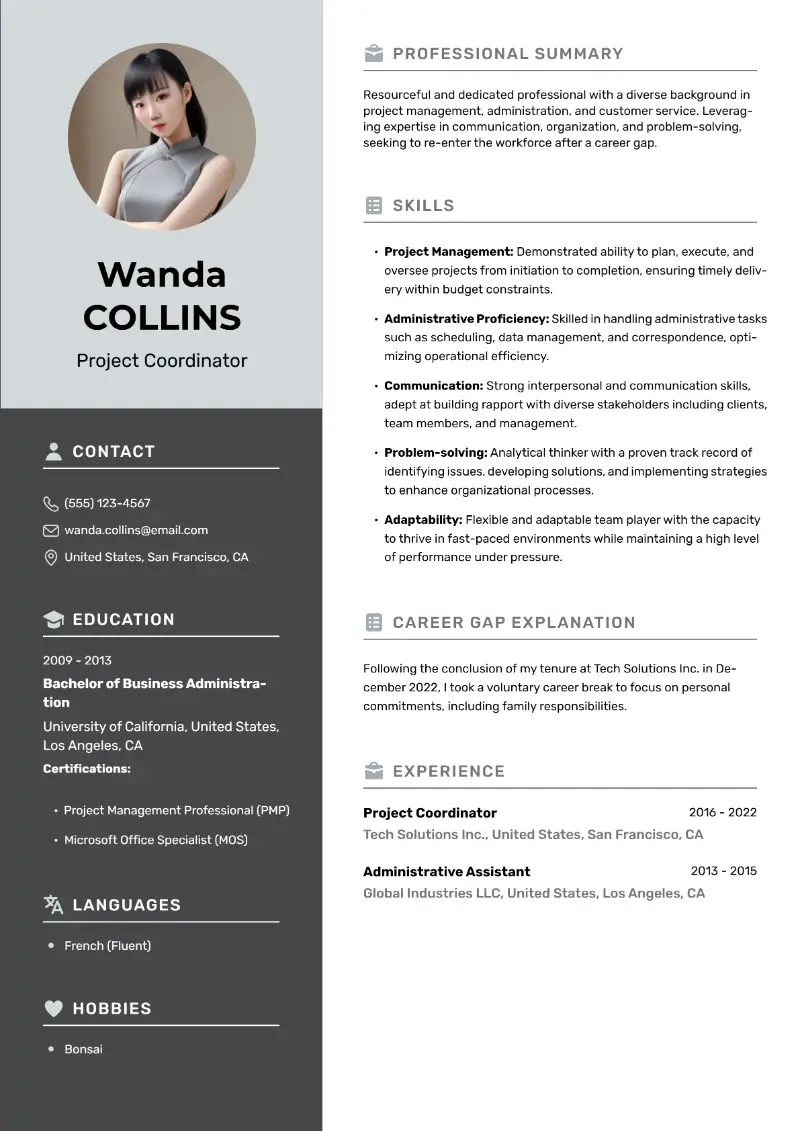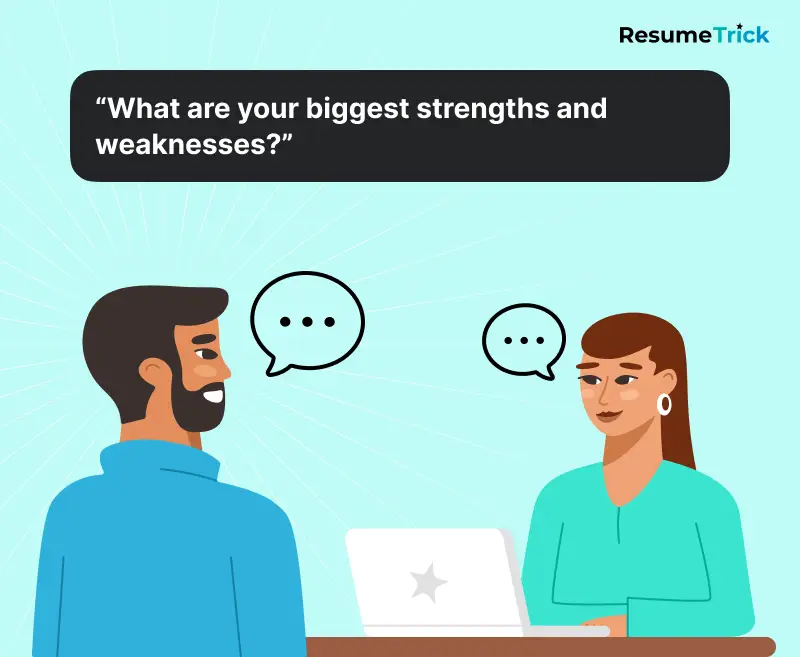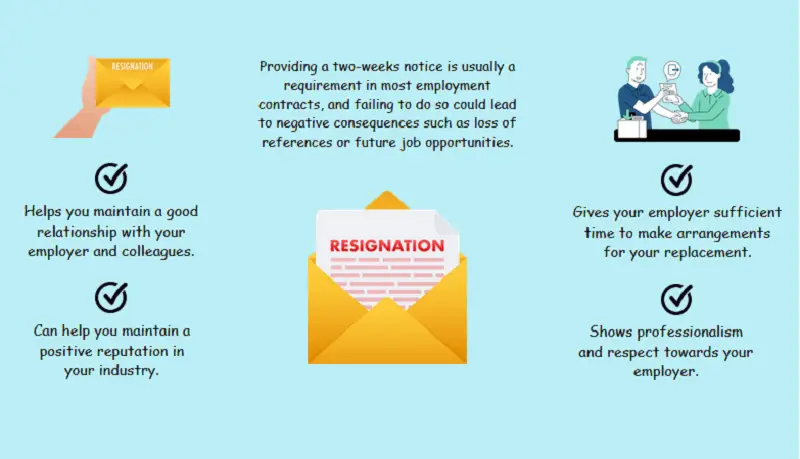No matter where you are in your career, writing a resume can be a difficult task. You need to sell a prospective employer on the value you create while touting your skills, achievements, and expertise using the right resume format.
Thankfully, there is an online resume helper with templates and examples that use proven, ATS-compliant strategies to help you create the perfect career document.
Create your professional Resume in 10 minutes for FREE
Build My Resume
However, most available free resume templates are what is called a "combination resume" and will suit professionals with an existing and consistent career history.
What if that doesn't apply to you? You could have limited experience or have a professional gap (for example for being a stay-at-home mom or dad). Then you need a seldom-used resume outline that highlights your skills rather than the experience.
In comes the functional resume.
What is a Functional Resume?
The functional resume (also known as a skill-based resume) places your mastery in the driver's seat. It prioritizes transferrable and pertinent skills to communicate the impacts you can make on an organization.
Instead of the reverse-chronological ordering, you see in most popular resume examples, in a functional resume your experience is divided by overarching skill sets, like problem-solving, data analysis, project management, etc.
You still include your professional experience but as an abbreviated section towards the end of the document.
To frame it another way, recruiters always want to see bullets on a resume, right? Rather than placing those bullets underneath a job title with a specific company, you attribute your accomplishments to an expertise category.
Other types of resume formats include:
- Chronological. This is the most common type of resume, where your work experience is listed in reverse chronological order, starting with your most recent job. This format is effective for showcasing job progression and stability.
- Combination. This type of resume combines elements of both the chronological and functional formats. It includes a summary of qualifications at the top, followed by a chronological work history section.
- Video. A video resume is a short video presentation where you introduce yourself and explain why you are the ideal candidate for a job. This type of resume allows you to showcase your personality and communication skills in addition to your qualifications.
When to Use a Functional Resume?
You should explore using a functional resume format if the usual reverse-chronological might uncover something that you would rather a recruiter or HR not see.
Main categories of people should turn to a functional resume template:
| Category | Description |
|---|---|
| Career Changers | You do not have enough experience, so you want to highlight transferrable skills that are pertinent to the desired position. This includes professionals who might have worked in a variety of roles, such as freelancers and temporary employees. |
| First-Time Job Seekers | You could be a recent graduate, student or someone who hasn't been employed before. As a result, you want to emphasize skills you have accrued through education, mentorship, and extracurriculars. |
| Professionals with Employment Gaps | You were away from the workforce for more than 2 years, so a chronological resume would highlight your hiatus, detracting from your existing expertise. |
| Professionals with Non-Traditional Experience. | You have a relevant skill set, but it isn't a result of "traditional" employment. For example, you might edit YouTube videos as a hobby but are looking to transform that into a full-time career. Other examples could include volunteering or professional development courses. |
| Frequent Job Hoppers | You've held multiple short-term positions, making a time-based resume appear unstable. A functional format helps you emphasize consistent competencies instead of dates and durations. |
You Should Probably Use a Combination Resume
While one of the above situations may describe you to a "T", you may still want to avoid writing a functional resume. Skills-based resumes are, by far, the least used type of resume format because the disadvantages of style often outweigh the positives.
Pros:
- Hides employment gaps.
- Organizes a varied work history.
- Displays non-traditional skills.
Cons:
- Non-ATS-friendly resume.
- Difficult for hiring managers to review.
- Hard to form a cohesive narrative.
- Can highlight lack of experience.
Now, let's compare that to the pros and cons of a combination resume, the professional resume format typically preferred by companies and recruiters.
Pros:
- ATS compliant.
- Easy for a hiring manager to skim.
- Reverse-chronology easily shows your career path.
- Highlights your most recent, and applicable, experience.
Cons:
- Adds attention to career gaps.
- Harder to structure and create.
- Lack of experience can make it feel unpopulated.
- Likely requires customization for each job posting.
For over 95% of professionals, the combination resume is going to be the best format. As it is easily parsed by both computer and human eyes, maximizing your chances of getting an interview.
If the combination resume is usually preferred, how can we circumvent some of the cons?
| Adds attention to career gaps |
|---|
| - Typically, you can directly explain career gaps by including the reason for your hiatus as a job title with the years. You can further address a gap in a cover letter and during the interview. |
| - Additionally, you can disguise small gaps by omitting months from your start and end dates. |
Example:
- Project Manager, O'Connell Group | 2022 - Present.
- Full-time Caregiver, Greenholt Inc | 2019 - 2022.
- Project Supervisor, Casper Ltd | 2018 - 2019.
| Harder to structure and create |
|---|
| - This is where resume templates and builder will be your best friend. They offer an invaluable and ATS-friendly starting point you can customize to best showcase your professional experience. |
Create your professional Resume in 10 minutes for FREE
Build My Resume
| Lack of experience can make it feel unpopulated |
|---|
| - Don't be afraid of having a little white space on your resume - it can actually help you! A resume with thoughtful white space is much easier for HR to skim than one that is just a wall of text. |
| - Most professionals don't need a resume that is longer than one page. You should only have a two-page resume when you have over 10 years of experience. And if you hold a position that is director-level or above. |
| - Include other resume sections, like "Volunteering", "Extracurricular activities" or "Professional Development", to fill out any needed space. Just like traditional work positions, these can substantiate key skills that could net you the position. |
Confining a resume to a single page is good advice for anyone.
| Likely requires customization for each job posting |
|---|
| - This one is harder to get around. To maximize your chances of landing an interview or continuing the conversation with a potential employer, it is always recommended that you customize your resume according to the job posting. You might find it useful to have multiple copies of the same resume that have slightly different emphases to aid your job search. |
| - Remember that these customizations often don't need to be comprehensive. Slight changes to your professional summary, and skill section, and a few bullets might be all that you need. |
How to Write a Functional Resume?
If you still want to use a skill-based resume, how do you go about creating one? Options for templates and guides are much more sparse than a combination resume.
Thankfully, in many ways, most sections are analogous between the two.
Let's go through the essentials, section by section of a functional resume, to ease the process as much as possible.
Header & Contact Information on a Functional Resume
A study by TopResume found nearly one in four applicants will fail to have all the necessary contact data. With this, 52% of employers would instantly reject a candidate if they don't include contact information.
In this section of functional resume, you must have your:
- Name.
- Phone number.
- Email address.
- Location (city and state only — no full address needed).
- LinkedIn profile or website (if applicable).
- Job title or branding statement (optional but helpful for clarity).
Tip: Always use a professional email. Ideally, it will be your name with no numbers, either a Gmail or personal domain. Consider making a dedicated address for a job search.
It may also benefit you to have your LinkedIn profile, job title, and personal website mentioned on your functional resume. For the former, only include the link if your profile is up-to-date and represents something that employers should see.
Ideally, you should be updating your LinkedIn profile every year. Or whenever you start a new job search as you could land your next big opportunity through the growing platform.
You can include your job title if your skills align with the position you are vying for. If you are a project supervisor looking to make the jump to a manager. However, if you are switching industries or focuses, you will likely want to omit the job title as it could confuse employers.
Finally, a website could be a hugely beneficial asset, especially if you are creative with a portfolio of work. Just as with a LinkedIn profile, ensure that it is something you want employees to see.
Refrain from including things like personal blogs or other social media pages unless they are directly related to your career focus.
Functional Resume Example:
John Doe
johndoe@gmail.com | (123) 456-7890 | linkedin.com/john.doe
Functional Resume Summary
Remember, a professional resume summary is very different from an objective statement. For the most part, objectives are outdated and will only invite eye-rolls from recruiters. The goal of your functional resume should always be to present the value you create. And not what you are hoping to get out of the position.
In your summary statement, you want to highlight your expertise, relevant skills, and some type of impact you've made in a previous role.
You want this section of a functional resume to be brief, no more than 3 sentences, since the longer it is, the less likely someone is to read it. Here's a rough template you can use to write your professional summary.
Example:
Results-driven professional with a proven track record in project management and strategic planning. Proficient in leveraging data analysis to drive business decisions and optimize processes, resulting in cost savings and efficiency improvements. Skilled communicator with a talent for building strong cross-functional relationships and leading teams to exceed goals.
Skills
In a traditional resume, your experience is the most important section. For a skills-based resume, you leverage an extended skill section to build your professional brand.
Instead of filing achievements under job titles, you will want to use functional resume headers, or headings that state a broad skill the subsequent bullets exemplify.
Just as with a reverse-chronological or combination resume, you want to omit all pronouns. Start each bullet with a strong action verb to engage the hiring manager.
With this, whenever possible, include some type of metric or number to substantiate your accomplishment, providing important context and enhancing its memorability.
For this example, the applicant is looking to transition into branding and content creation from a background in customer service and retail.
Client Relations
- Evaluated the needs of over 20 clients daily to synthesize tailored solutions that leveraged proprietary technologies.
- Cultivated relationships with key, high-spend customers to boost acquisition rates by 15% and retention by 34%.
Brand Development
- Increased personal website traffic by 17% after SEO enhancements driven by Google Trends research.
- Represented Company X as a brand ambassador at local events and concerts.
Professional Experience
You've put in the hard work with your skills section, so now your experience block should be a breeze.
For a functional resume format, you don't need any bullets, responsibilities, or achievements tied to a specific role.
On a functional resume you will only need the essentials:
- Job Title.
- Company.
- Start and End Years.
- Location (sometimes).
Even if you are using a skill-based resume due to a career gap, you will want to include the years at a given position. Remember you can add the reason for the hiatus as a position (per the example earlier in the article).
For that same applicant, their professional experience section may look something like this:
Project Manager | Acme Solutions Inc., New York, NY
- June 2018 - Present.
- Lead cross-functional teams to successfully deliver multiple projects on time and within budget.
Operations Analyst | BrightStar Corporation, San Francisco, CA
- January 2015 - May 2018.
- Conducted comprehensive data analysis to identify cost-saving opportunities and streamline operational processes, resulting in a 10% reduction in expenses.
Education on functional resume
Most functional resumes will conclude with a straightforward education section.
However, if you are a recent graduate, you may elect to move this section to the top, after your professional summary, as the skills you developed during your schooling are much more relevant.
You can also turn this section into an "Education & Certifications" one. This is especially useful for those looking to change careers as it can show expertise in a skill without practical experience.
Some other tips:
- If within 5 years of graduation, include any honors gained and your GPA (if it's over 3.5).
- You can likely omit your high school degree on a functional resume. A much better use of space would be another bullet or two to support your skill set.
- Also consider including coursework - a semester dedicated to the study of Tableau fundamentals could lead to an entry-level data analyst position, for example.
- Highlight bootcamps, workshops, or online training relevant to the target role — these can be just as persuasive as formal diploma.
Functional resume example
Bachelor of Arts, Communications | Missouri State University, 2017
- GPA: 3.8, Phi Beta Kappa Honors Society
- Relevant Coursework: Introduction to Accounting, Financial Planning & Analysis, Finance Fundamentals for Startups, FinTech Principles
Functional Resume Examples
Career Gap
Recent Graduate
Mary J. Vacca
Stockton, CA
Phone: (124) 325-7458
Email: maryjvacca@email.comObjective:
Motivated and adaptable individual eager to launch a successful career in Business Administration. Possessing a strong work ethic, excellent communication skills, and a commitment to learning and growth, I am seeking an entry-level position where I can apply my enthusiasm and drive to contribute to the success of the team.
Relevant Skills:
- Excellent verbal and written communication skills developed through academic projects, extracurricular activities, and volunteer work.
- Strong analytical and critical thinking abilities, with a demonstrated capacity to identify issues and develop effective solutions.
- Proven ability to collaborate with diverse teams to achieve common goals and objectives.
- Flexible and quick to learn, with the ability to thrive in fast-paced environments and embrace new challenges.
- Effective organizational skills and the ability to prioritize tasks to meet deadlines and deliver results.
Additional Skills:
- Proficient in Microsoft Office Suite (Word, Excel, PowerPoint).
- Basic knowledge of CRM software such as Salesforce.
- Fluent in English and Spanish.
Projects:
Marketing Campaign Project, UCLA, January 2023 - May 2023
- Developed a comprehensive marketing campaign for a local nonprofit organization, including market research, strategic planning, and promotional materials creation.
- Led a team of four students to execute the campaign, achieving a 20% increase in community engagement and donations.
Education
Bachelor of Science in Business Administration
University of California, Los Angeles (UCLA), CA, August 2020 - May 2024
- Relevant coursework: Marketing Principles, Financial Accounting, Business Communication, Organizational Behavior.
- Participated in group projects simulating real-world business scenarios, developing teamwork and problem-solving skills.
Non-Traditional Experience
Career Changer
Willie D. Torrance
Gardena, CA
Phone: (254) 864-7878
Email: williedtorrance@email.comObjective:
Enthusiastic and dedicated individual with a passion for teaching, seeking a fulfilling opportunity as a Math Teacher to inspire and educate students. Leveraging strong communication skills, patience, and a commitment to student success cultivated through customer service experience to create engaging learning environments and promote academic excellence.
Summary of Qualifications:
- Strong passion for mathematics and a desire to share knowledge with students.
- Excellent communication and interpersonal skills developed through customer service roles.
- Patient and empathetic approach to understanding and addressing students' needs and challenges.
- Proven ability to adapt quickly to new environments and learn new skills efficiently.
Volunteer Experience:
Math Tutor
Local Community Center, Gardena, CA, September 2019 - May 2020
- Provided individualized math tutoring to students in need of extra support.
- Adapted teaching methods to suit the learning styles and abilities of each student.
- Fostered a positive learning environment to encourage student engagement and confidence.
Experience:
Customer Service Representative
Johnson & Johnson, Los Angeles, CA, June 2021 - Present
Skills:
- Utilizing project management tools (MS Project, Monday).
- Word processing (Microsoft Word, Google Docs).
- Investigating data (Excel, Tableau).
Education:
Bachelor of Science in Mathematics
University of California, Los Angeles (UCLA), CA
Graduation Date: May 2021
Limited Experience
Re-entering the Workforce
Emily Johnson
Chicago, IL
Phone: (312) 555-7890
Email: emily.johnson@email.comObjective:
Dynamic and organized professional seeking to re-enter the workforce in a marketing coordinator role. Offering a strong background in project management, communication, and creative problem-solving, with a passion for driving successful marketing initiatives.
Skills:
- Project Management: Expertise in planning and executing marketing campaigns from conception to completion.
- Digital Marketing: Proficient in SEO, social media marketing, and email campaigns, with a focus on data-driven strategies.
- Communication: Strong verbal and written communication skills, with experience in creating content for diverse audiences.
- Analytical Skills: Skilled in analyzing market trends and campaign performance metrics to drive improvements.
- Software Proficiency: Experienced with Adobe Creative Suite, Google Analytics, HubSpot, and Microsoft Office Suite.
Relevant Experience:
Volunteer
Chicago Public Library, Chicago, IL
March 2023 - Present
- Collaborate with library staff to create promotional materials for events, increasing attendance by 50%.
- Manage the library's social media accounts, developing engaging content that grew follower engagement by 30%.
- Assist in organizing community outreach programs, focusing on literacy and education initiatives.
Freelance Marketing Consultant
Self-Employed, Chicago, IL
June 2021 - February 2023
- Developed and executed marketing strategies for small businesses, improving online presence and customer engagement.
- Conducted market research to identify target demographics, tailoring campaigns to meet specific needs and preferences.
- Provided training and support to clients on digital marketing tools and techniques.
Professional Experience:
Marketing Coordinator
Green Thumb Industries, Chicago, IL
January 2017 - December 2019
- Coordinated marketing campaigns for a leading cannabis company, managing timelines and budgets to ensure successful execution.
- Developed content for newsletters, social media, and the company website, increasing brand awareness and customer engagement.
- Analyzed campaign performance and generated reports to present to management, contributing to strategic planning.
Education:
Bachelor of Science in Marketing
DePaul University, Chicago, IL
Graduated June 2016
Freelancer
Create your professional Resume in 10 minutes for FREE
Build My Resume
Writing a Functional Resume: Conclusion
While rarely used (and with good reason), the skills-based resume can be a boon to a professional who has found themselves in a unique situation or is looking to break into a new industry. It highlights your skills, rather than your career history, to showcase the value you can create for an employer.
If you find yourself searching for work in a new sector, after a break from the workforce, or as a budding professional, the functional resume could be the style you need to nab your next opportunity.
FAQ
- How long should a functional resume be?
- Like any resume, it should ideally be one page, but two pages are acceptable for those with extensive experience.
- Should I include references on a functional resume?
- No, references should be provided separately upon request.
- What's the difference between a functional resume and a CV?
- A CV is a longer, more detailed document used primarily for academic positions, while a functional resume is concise and job-focused.
- How do I show promotions?
- You can mention promotions in the professional achievements section to show career progression.
- How do I handle short-term jobs in my functional resume?
- Group similar temporary positions under a single category to avoid listing each one separately.
- Can I use a functional resume for online applications?
- Yes, but be cautious — some ATS systems prefer chronological formats. To improve parsing, consider a hybrid structure or employ a simplified work history at the end.







